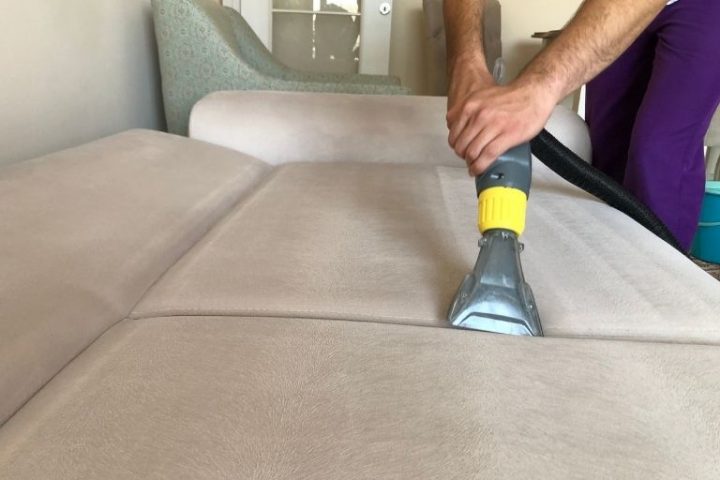Fabric surfaces on boats are problematic for a few reasons. The biggest problem is that these surfaces are excellent at trapping moisture and grime. That makes them hard to clean and hard to keep dry. In the moisture-rich marine environments that are so fun to play in, the result is almost always mold and mildew.
Table of Contents
Furthermore, fabrics are the first thing on your boat to start to show damage from the sun’s UV rays. So keeping the sun off your boat year-round can go a long way in maintaining your marine fabrics’ appearance and longevity.
We’ll look more closely at how to remove ugly mold and mildew stains in our next article, but for now, let’s focus on a more positive subject—how to keep it from happening to you in the first place.
Keeping your boat’s upholstery clean and dry is the key to making it last longer. Let’s look at what we can do to make our boat seats last longer, prevent mold, and look new for years to come.

Tips on How to Clean Boat Seats
Identify the Material
Exterior marine cushions and upholstery are usually made out of one of two materials—smooth marine-grade vinyl or exterior canvas. Each one has different care requirements, and both surfaces are prone to mildew problems if left untreated too long.
While vinyl boat seats may look smooth and hard, they are actually quite porous. Like the gel coat on your fiberglass hull, if abused by the sun and left without its protective coating, vinyl fabrics will begin to deteriorate and soak up moisture and grime in no time.
Many canvas surfaces have the benefit of being removable. If your cushions have a zipper on the back or the bottom, it might be easier to remove the cover from the seat and then clean it. It is possible to machine wash some canvas boat cushion covers.
Reduce UV Damage
The key to keeping your boat seats looking new is to keep them out of the sun. Ultraviolet radiation is harmful to nearly everything it’s exposed to, from the boat’s gel coat to the seats and even your skin.
When not in use, put a cover over your seats. If possible, stash the seats down below when you’re away from the boat. If you’re laying the boat up for storage, remove the seats and cushions and put them somewhere out of the elements. Doing so can add years to the lives of your expensive upholstery.
Avoid Items that Will Stain
Knowing that vinyl is porous is crucial because it will become evident that it can easily be stained. Lots of things you never even think about get soaked up by the material and can leave unsightly marks. One prime culprit is sunscreen, which contains lots of nasty chemicals that can discolor vinyl.
But that’s just the beginning of the list. Other plastics, stickers, cardboard packaging, and printed items like magazines can all make a huge mess if left on your seats. See our next article for tips on removing these stains. For now, do everything you can to avoid the problem altogether. Take care of your seats and keep everything off of them. If something does get on them, wash them with soap and water carefully before trying anything stronger.
Avoid Harsh Chemicals and Abrasive Cleaners
Before you go grinding away at your vinyl, realize that it’s actually quite expensive to replace and easy to damage.
The most significant risk with using harsh chemicals and abrasives is the damage it does to the material’s protective coating. Harsh chemicals can eat right into the fabric itself, making it thinner and more likely to be affected by stains and UV damage in the future.
There is no substitute for regular soap and water. Boat soap works exceptionally well, and it’s not going to damage vinyl or canvas. If your fabric is textured, like canvas or nicer vinyl, use a small soft nail brush to scrub the soap into a lather.
Specialty Cleaners for Vinyl
You’re not the only one having trouble keeping your vinyl boat seats clean. The marine supply store will have several options of cleaners available. You may not need these products if you keep your seats in good condition with care and frequent washings. If you do need them, however, they can remove some tough stains, and you can use them to help beef up the vinyl’s protective coating.
3M and Star-Brite make the best-regarded cleaners for vinyl. There are even gel-consistency options if you need the cleaner to soak in for longer or to use it on overhead liners.
Steps to Properly Clean Your Boat Seats
Wash Thoroughly
Step one to care is frequent washing with lots of clean water and regular soap. Don’t use bleach or anything harsh on the vinyl. Just regular boat or dish soap and a soft brush are all that’s needed to get the grime off and make the surface clean.
The wash is essential to remove contaminants, many of which you can’t see and don’t even know are on there. The craziest things can discolor vinyl if left out in the sun. Sunblock that rubs off your legs, for example, is a substance that no one thinks about yet everyone experiences.
Head-off problems by simply washing down the boat seats after every use.
Sunbrella Care and Cleaning
Canvas upholstery is slightly different than vinyl in terms of care requirements. Like vinyl, both fabrics have sturdy UV-resistant coatings. While marine-grade vinyl wipes off and makes everyday cleanings easier, deep cleaning canvas can be easier.
You can find the best care instructions for name-brand Sunbrella on the company’s website. Start with a basic wash, just like vinyl surfaces. If that doesn’t do, Sunbrella says you can use a diluted bleach solution on all colors of their exterior marine fabrics.
Sunbrella covers can often be removed and soaked in a soapy water solution overnight. This is a great way to get general grime and chemicals off the seats, but it only works if your cushions have zipper covers. Otherwise, wipe the canvas down with a soft boat brush and lots of regular boat soap. Only break out the heavy guns for soiled or stained fabrics.
Rinse Thoroughly
Once you’ve scrubbed your cushions, make sure to rinse all of the cleaning chemicals out with lots of fresh water.
If your upholstery is starting to mildew easily, it might be time to replace the protective coating. 303 spray is one of the most straightforward products to use, but make sure you follow the instructions carefully.
Allow Cushions to Dry Thoroughly and Store Under Cover
Maybe the most overlooked step in keeping your cushions clean is drying. No matter how your seats are made, they will trap some water in the foam. If you can lift the cushions off the seats and stand them on end to dry, that’s a good start.
Once the seats are dry and you’re putting the boat away for the night, cover them with something. Seat covers need to allow for airflow since the worst thing you could do is trap in moisture. But ideally, you can work out a system that keeps the air moving while blocking the sun’s harmful UV rays. If your cushions are removable, store them below decks when not in use.

Conclusion
To prevent mold and mildew, you’ve got to eliminate the wet environment in which they love to grow and spread. Cushions and upholstery are, unfortunately, the perfect place for these fungi to spread their evil spores.
Believe it or not, frequent washings are enough to keep your seats looking great for decades. But, unfortunately, it’s the periods of inactivity that will get you—when the boat goes into storage and the seats are left damp. And unfortunately, it doesn’t take long for those nasties to appear!
Check out our next article on removing troublesome stains, especially those hard-to-remove mildew spots.
